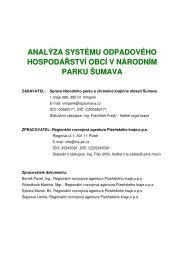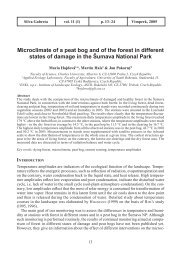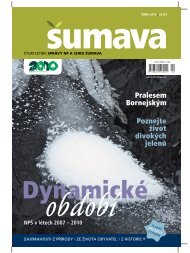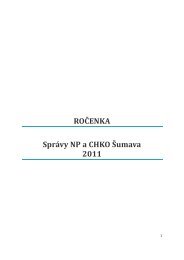(Pseudophilotes baton) (Lepidoptera: Lycaenidae) - Národní park ...
(Pseudophilotes baton) (Lepidoptera: Lycaenidae) - Národní park ...
(Pseudophilotes baton) (Lepidoptera: Lycaenidae) - Národní park ...
You also want an ePaper? Increase the reach of your titles
YUMPU automatically turns print PDFs into web optimized ePapers that Google loves.
main insufficiently known: the sibling P. vicrama is positively known from environs of<br />
Prague and environs of Třebíč (western Moravia). If there had been a past hybrid zone<br />
between the two species, it was interrupted long ago by profound land use changes.<br />
The butterfly has declined from 27 grids cells occupied in the past to just eight cells at<br />
present. However, recent work led to the discovery of several new sites, the rediscovery of<br />
others, and even the detection of the butterfly in a previously unrecorded grid cells. All these<br />
discoveries might imply that the species’ status is not critical and that many undiscovered<br />
populations may exist within the area of occurrence. This, however, does not seem to be<br />
likely. Past authors were not particularly interested in this species, which is, due to its small<br />
body size, patchy distribution and unpredictable timing of flight period (caused by its wide<br />
altitude range), extremely hard to detect. The very fact that unmotivated past authors kept<br />
discovering sites, whereas at present, discovery of each new site requires painstaking focused<br />
searches, suggests a staggering loss of colonies. All existing sites are extremely small,<br />
none exceeds 1 ha, all host at most a few dozens of adults, and the majority of them (except<br />
for Boletice and Kašperské Hory) are extremely isolated.<br />
A persistence of a P. <strong>baton</strong> colony requires an irregular but rather intense disturbance<br />
regime, suppressing the ground vegetation and exposing the bedrock. In a distant past, such<br />
disturbances followed events such as landslides or erosive action of unregulated rivers (LEP-<br />
IDOPTEROLOGEN-AREBITSGRUPPE 1987, EBERT & RENNWALD 1991). In pre-modern cultural landscapes,<br />
suitable conditions existed on erratically used pastures (= village commons). Suitable<br />
sites were not necessarily large and long lived, but existed in a high density, probably allowing<br />
the species to persist in dynamic metapopulations (cf. WAHLBERG et al. 2002). Indeed,<br />
multiple sites still exist until now on former pastures. The twin effects of land use intensification<br />
and abandonment have forced the species to a handful of retreats, where suitable<br />
disturbance regimes persisted for a longer time owing to, e.g., to military (Boletice) or police<br />
force (Dolní Dvořiště, Studánky) activities, mineral extraction (Novohradské Hory Mts.), or<br />
even continuation of grazing. The military/police activities deserve to be highlighted here:<br />
they tend to produce rather severe but irregular disturbances and allowed the butterfly to<br />
survive a long period of complete abandonment of some regions, such as the strip adjoining<br />
Czech-German borders. Positive influences of army activities on insect diversity were described<br />
from other regions as well (e.g., VAISANEN et al. 1994, WARREN & BÜTTNER 2009).<br />
The main reason for losses of past sites was successional overgrowth (e.g., multiple sites<br />
near Blatná, Pohoří na Šumavě, Stachy, Opolenec near Vimperk). Some colonies could have<br />
been lost just due to stochastic processes affecting small populations. For example, the Na<br />
Stráži Nature Monument within the Blanský Les PLA has been appropriately managed during<br />
the 1990s, P. <strong>baton</strong> was regularly observed until 2002–2004, but disappeared in 2005.<br />
The preference for host plants growing as short cushion over exposed bedrock, and associated<br />
dependency on disturbed ground, applies for all <strong>Pseudophilotes</strong> species studied in<br />
some detail, be it P. abencerragus (Pierret, 1837) in Spain (MATTONI 1980), P. barbagiae De<br />
Prins & Poorten, 1982 in Sardinia (LEIGHEB & CAMERON-CURRY 1998, GRILL et al. 2002), P.<br />
sinaicus Nakamura, 1975 in Middle East (HOYLE & JAMES 2006), or P. vicrama in Northern<br />
Europe (MARTTILA et al. 1997). The peculiar requirements also explain an association<br />
between these species and intensive disturbance activities. In Finland, P. vicrama has retracted<br />
only to military training grounds, and has been rescued via purposeful disturbance by<br />
heavy vehicles and prescribed burning, carried out jointly by conservationists and Finnish<br />
military; another conservation action was a release at rocky highway verges (VAISANEN et al.<br />
1994, MARTTILA et al. 1997). P. vicrama has also declined strongly in the Czech Republic;<br />
some of its classical populations, such as those within the city of Prague, have diminished to<br />
handfuls of individuals and display an association with trampled paths crossing calcareous<br />
194



![Zima 2008 [4MB] - Národní park Šumava](https://img.yumpu.com/21236024/1/184x260/zima-2008-4mb-narodni-park-sumava.jpg?quality=85)






